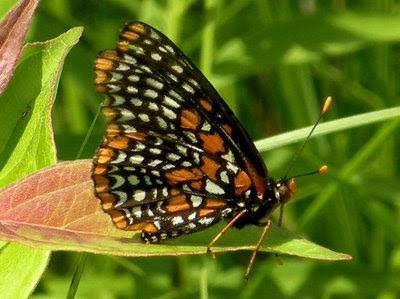Michigan Myrmecophily

Allegan State Game Area, Allegan County, Michigan
On Wednesday the Imperiled Butterfly Conservation and Management Workshop traveled from Toledo to the Allegan State Game Area in Western Michigan. Our goal was to see the population of Karner Blue butterflies that was used as the source of material bred for release in Ohio. In addition to a huge population of federally endangered Karner Blues, Allegan is home to a sizeable population of Edwards Hairstreaks, an uncommon butterfly of oak barrens.
Karner Blues and Edwards Hairstreaks are both members of the gossamer winged butterflies, or Lycaenidae. Along with many other lycaenid butterflies, they have a close relationship with ants, called myrmecophily. The relationship involves the caterpillars.

A Karner Blue caterpillar emits scents and ecven sounds that attract certain species of ants. When they detect the caterpillar, they approach it and begin stroking it with their legs and antennae. The caterpillars have special organs on their skin that emit droplets of a nutritious liquid called honeydew. The ants consume the honeydew, and drive off parasitic flies and wasps that may try to attack the caterpillar.
This mutualistic relationship is carried even further when the Edwards Hairstreak is involved. The ants will actually carry the caterpillars back to their nests. What starts out as a mutualistic relationship turns partly parasitic, as the caterpillars may include ant larvae in their diets. The caterpillars pupate underground. When the adults emerge from the pupae, they must quickly leave the ant mound, as they no longer produce the pheromone that calms the ants. Many species have deciduous scales. These scales quickly drop off when ants attacking the fleeing adult butterfly grab onto them.

At the Allegan Game Area, one of the ant species that interacts with the Edwards Hairstreak is the Allegheny Mound Ant. These were common in the area where we found the Edwards Haristreaks. Dozens of ant monds were found in the oak scrub, and getting nipped was a hazard of trying to photograph the butterflies. The mounds that they build are impressive- the largest was nearly 3 feet tall.

The complex relationship between Edwards Hairstreak and various ant species may in part explain why it is so much less common than the very similar Banded Hairstreak (Satyrium calanus) in my part of the country. The latter species does not share this complex relationship, and can perhaps better survive in oak woodlands that lack appropriate ant species.
Labels: Ants, Butterflies, Endangered Species, IBCM, Mutualism

































